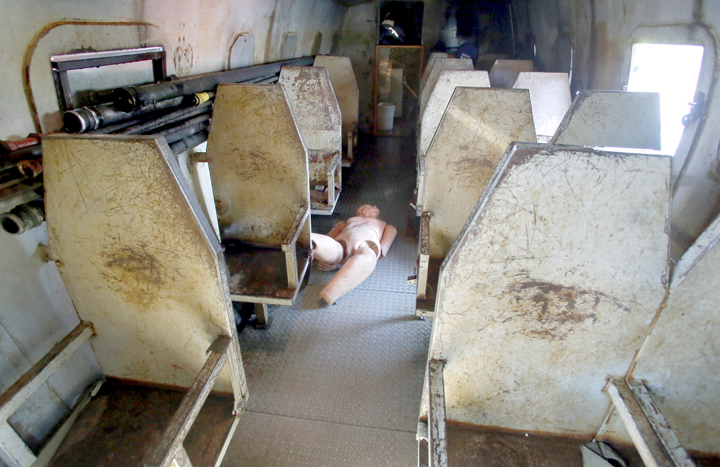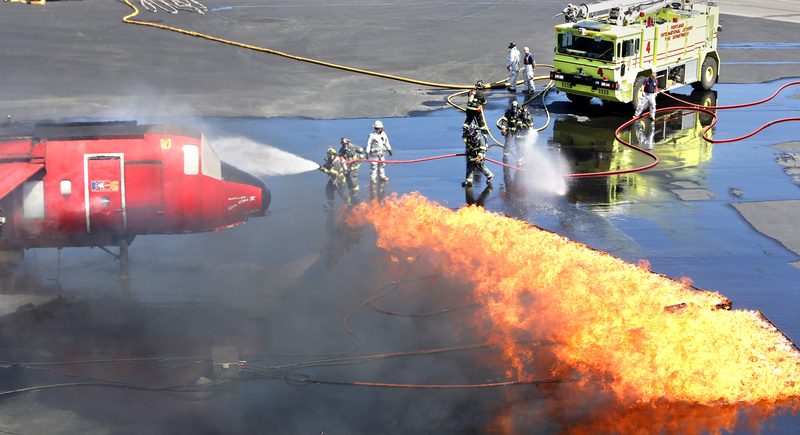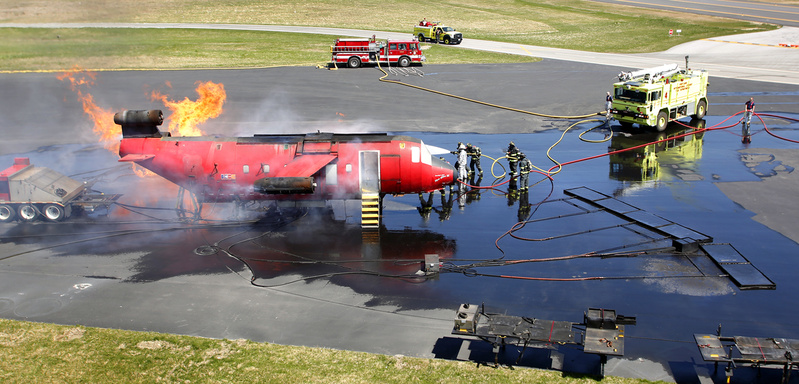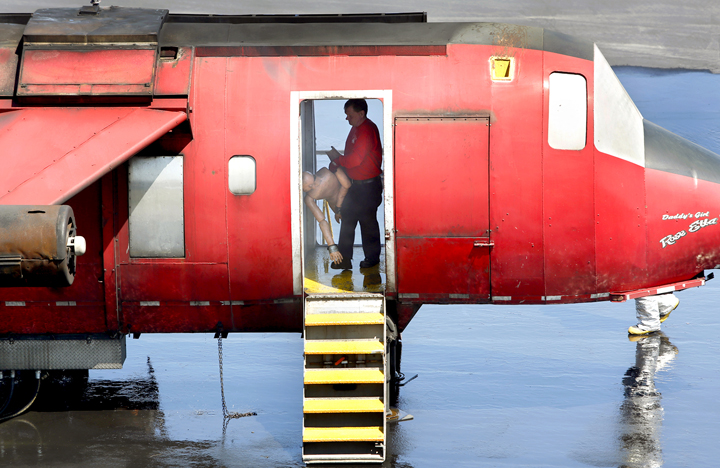Flames erupted from the pavement alongside a Portland International Jetport runway and roared from the top of a burned-out airplane fuselage, so real it would impress any Hollywood special effects wizard.
There were even fake screams.
And like a hard-to-please director looking for just the right shot, firefighters from the Portland Air Rescue Firefighting team and surrounding departments had to repeatedly replay efforts to douse the fire and rescue make-believe passengers.
The goal wasn’t the perfect simulation, but instead to give firefighters a taste of what a real air disaster would be like.
“They have to establish a rescue path . . . so if there are any occupants trying to escape, they will run into the escape path to safety,” said Portland Fire Chief Jerome La- Moria, explaining the tactics of fighting an airplane fire. “Then ground crews pull hand-held hoses and actually enter the burning plane to rescue any occupants that are left behind.”
The training, held Monday and Tuesday, was orchestrated by Kellogg Community College’s Aircraft Rescue Fire Trainer, a 50-foot-long simulator that was built for the Federal Aviation Administration and leased to the Michigan college for on-location training nationwide.
All major airports need fire crews that have an annual FAA training certification.
“Aviation safety is the most important thing we do,” said Paul Bradbury, jetport director, explaining why the annual training is required. “It’s one aspect that makes aviation the safest way to travel.”
Authorities now believe if firefighters can get to a burning aircraft within three minutes, there’s a good chance they can rescue survivors, which was not always the case, he said.
The city would typically budget $50,000 to send firefighters out of state for training, LaMoria said.
Using the Michigan-based mobile trainer costs about half as much — the final tally will depend on how much fuel they use — and allows firefighters to train on the equipment they would actually be using in an emergency with other Greater Portland departments that would respond to the jetport, LaMoria said.
Bringing the training to Maine also meant a savings for other departments that participated: those with airports, like Bar Harbor, Brunswick and Bath.
Firefighters were able to practice directing high-powered streams of water — in a real emergency they would be using fire-suppressing foam — to clear a path to the burning plane. Then firefighters on foot, some in protective silver suits, used the hand-held hoses to clear a path and enter the aircraft.
The crews were practicing techniques and making sure they can work together seamlessly in life-and-death situations, said Deputy Chief Robert Stewart, who oversees the air rescue unit.
Once inside, firefighters had to work through faux smoke in the cockpit to pull the throttles back to neutral, activate the plane’s fire suppression equipment to douse fire in the engines, and shut down the electronics.
Meanwhile, firefighters made their way down the aisle to retrieve life-size mannequins and carry them to safety outside.
Heat from the very real flames could be felt 30 yards from the simulator. The flames were not burning jet fuel, but propane that was controlled from a nearby command center.
From the converted sleeper of a nearby tractor-trailer truck, Richard Fletcher kept tabs on the suppression effort, using closed-circuit television cameras to monitor temperatures inside the plane.
He manipulates the height of the flames based on how well the firefighters apply their spray patterns.
If the temperature gets too hot or the equipment senses a propane leak, it will automatically shut down, he said.
Fletcher, who worked for years as an active-duty firefighter with the Air Force, now does a similar assignment with the National Guard in addition to his training work with the college.
One firefighter complimented Fletcher on his simulation, saying manufactured flare-ups while the crews were inside the aircraft are the kind of unforeseen event that firefighters would have to adapt to during an operation.
Portland’s Air Rescue Firefighting Division has the city’s most sophisticated and specialized firefighting apparatus. “Red Four,” the department’s heavy rescue truck at the airport, has a roof-mounted “snozzle” to direct intense bursts of foam from high up in the air.
That’s important, said Fletcher, to prevent flaming liquids from splashing up into the area where firefighters are planning a rescue.
Then a bumper-mounted nozzle spreads the flames to either side, creating the rescue path.
The roof-mounted apparatus includes a harpoon-like device designed to puncture the skin of an aircraft to release heat and fill it with foam if needed, though that wasn’t used Tuesday.
LaMoria said he was pleased with the caliber of the training.
“It’s a very realistic exercise and it is very important to maintain this very technical, high-level ability of our airport rescue firefighters,” he said.
David Hench can be contacted at 791-6327 or at:
dhench@mainetoday.com
Send questions/comments to the editors.







Comments are no longer available on this story